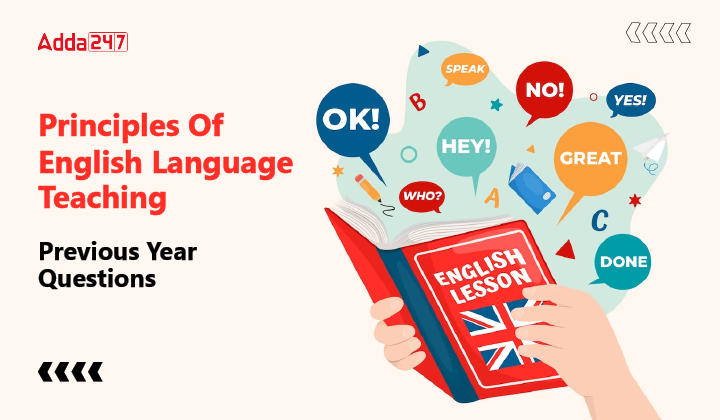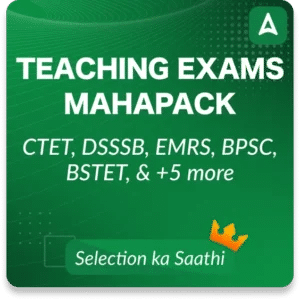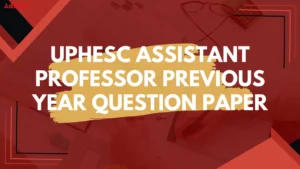In numerous teaching examinations, such as CTET and other State TETs, there is a compulsory section consisting of 15 questions on English content and 15 questions on English Pedagogy. English Pedagogy proves to be a captivating and high-scoring topic within the English Language section of these teaching exams. In this article, we present you with the previous year questions organized by topic to aid in your preparation.
Principle of Language Teaching (Previous Year Questions)
Q1. Which of the following is suitable for making students responsible for their own learning?
(a) Using technology to chat and network
(b) Encouraging students to ask more and more questions
(c) Giving a lot of homework, project work and assignments to improve language skills of students
(d) Discouraging students from making decisions about how they learn best
Q2. The Constructivist Approach to learning means
(a) teaching rules of grammar and consolidating through rigorous practice
(b) helping learners acquire new vocabulary by studying literature intensively
(c) teaching new words and structures using a variety of audio – visual aids followed by practice through drill
(d) involving the students in a variety of activities to encourage them to learn new words and structures by accommodating them with those that they have already learnt through a process of discovery
Q3. When learners are engaged in a pair activity, taking on roles of a doctor and a patient, the activity is called
(a) declamation
(b) simulation
(c) exchanging notes
(d) real activity
Q4. Gender stereotypes and bias among learners can be discouraged by
(a) using textbooks which do nor perpetuate such beliefs
(b) creating an open and encouraging atmosphere in a mixed class
(c) pressuring girls to learn cooking
(d) enabling all learners to cook and sew irrespective of gender
Q5. A child-centred classroom is characterized
(a) very passive teachers and active learners
(b) a variety of learning activities for the learners
(c) children sitting in the center of the classroom
(d) children teaching other children under the supervision of the teacher.
Q6. When a teacher uses lessons in Science and Social Science to teach language, such an approach can be termed as
(a) language across the curriculum
(b) objective language teaching
(c) pluralistic language teaching
(d) discipline – wise language teaching
Q7. After reading a story on fish, if a teacher asks children to answer. . . . “Imagine you are a fish in a pond. What do you see around you?” This is an example of
(a) multiple choice question
(b) comprehension question
(c) cloze type question
(d) open-ended question
Q8. Constructivist approach to language teaching expects the teacher to
(a) help construct knowledge using their experiences
(b) give pre – constructed knowledge to learners
(c) construct his own curriculum
(d) fake learners prepare their own textbooks
Q9. “You ask, what has my government done for you?
I can answer in two words: A lot!”
The question put here is
(a) Rhetorical
(b) A prompt
(c) Stylized
(d) Explanatory
Q10. ‘Gender sensitization’ in the school curriculum implies
(a) children should be differentiated as boys and girls
(b) sex education from primary school onwards
(c) respectful approach towards defining gender roles
(d) promote co – education in high school
Q11. The ‘question’ How will I achieve my teaching goal? In the design of a language instruction, which helps the teacher to ‘keep the lesson on target’ is/are the
(a) objectives
(b) methodology
(c) evaluation
(d) documentation
Q12. _____________________ is the particular way a learner prefers to learn a second or foreign language.
(a) Cognitive style
(b) Cognitive process
(c) Behaviorist approach
(d) Literal approach
Q13. The focus is on using the language rather than analysis of the language and grammar is taught implicitly rather than explicitly.
(a) Direct approach
(b) Communicative approach
(c) Grammar – translation method
(d) Structural method
Q14. Constructivist approach to learning does not emphasize
(a) that authentic task in a meaningful context should be used
(b) teaching as the transmission of knowledge from the enlightened to the unenlightened
(c) that learners construct knowledge for themselves
(d) knowledge construction instead of knowledge reproduction
Q15. A learner – centered class should not be one where
(a) the learners should do the given exercise silently as silence is better for learning to occur
(b) the learner’s personal views and feelings are taken into consideration
(c) the learners are intrinsically interested and are inclined to explore
(d) the teacher acts more as another participant in the learning process
Solutions
S1. Ans.(b)
Sol. When teachers ask higher‐order questions and encourage explanations, they help their students develop important critical thinking skills. By modeling good questioning and encouraging students to ask questions of them, teachers can help students learn independently and improve their learning.
S2. Ans.(d)
Sol. The Constructivist Approach to learning means involving the students in a variety of activities to encourage them to learn new words and structures by accommodating them with those that they have already learnt through a process of discovery.
S3. Ans.(b)
Sol. When learners are engaged in a pair activity, taking on roles of a doctor and a patient, the activity is called simulation.
S4. Ans.(b)
Sol. Gender stereotypes and bias among learners can be discouraged by creating an open and encouraging atmosphere in a mixed class.
S5. Ans.(b)
Sol. A child – centered classroom is characterized a variety of learning activities for the learners.
S6. Ans.(a)
Sol. When a teacher uses lessons in Science and Social Science to teach language, such an approach can be termed as language across the curriculum.
S7. Ans.(d)
Sol. Open-ended questions allow to collect qualitative answers from customers that are, for the most part, full of information. By asking an open-ended question, you are giving your customers the opportunity to answer whatever they like, without limiting or influencing them with predefined answers. The given example is an example of open – ended question.
S8. Ans.(a)
Sol. Constructivist approach to language teaching expects the teacher to help construct knowledge using their experiences.
S9. Ans.(c)
Sol. Stylized
S10. Ans.(c)
Sol. ‘Gender sensitization’ in the school curriculum implies respectful approach towards defining gender roles.
S11. Ans.(a)
Sol. Learning objectives are brief statements that describe what students will be expected to learn by the end of school year, course, unit, lesson, project, or class period. In many cases, learning objectives are the interim academic goals that teachers establish for students who are working toward meeting more comprehensive learning standards.
S12. Ans.(d)
Sol. Cognitive style is the particular way a learner prefers to learn a second or foreign language.
S13. Ans.(b)
Sol. The communicative approach is based on the idea that learning a language successfully comes through having to communicate real meaning. When learners are involved in real communication, their natural strategies for language acquisition will be used, and this will allow them to learn to use the language.
S14. Ans.(c)
Sol. Constructivist approach to learning does not emphasize that learners construct knowledge for themselves.
S15. Ans.(c)
Sol. A learner – centered class should not be one where the learners are intrinsically interested and are inclined to explore.




 UGC NET Previous Year Question Paper, Do...
UGC NET Previous Year Question Paper, Do...
 UP GIC Lecturer Previous Year Question P...
UP GIC Lecturer Previous Year Question P...
 UPHESC Assistant Professor Previous Year...
UPHESC Assistant Professor Previous Year...














